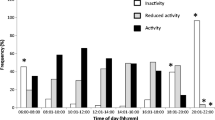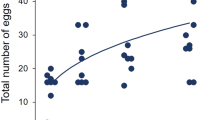Abstract
MaleRhagoletis boycei flies (Cresson) have been shown previously to guard egg-laying punctures on host walnut (Juglans major) fruit. During their tenure,R. boycei males were observed to dip the posterior portion of their abdomen repeatedly toward the fruit surface. Closeup video analysis revealed that, during this dipping behavior, a clear viscous substance emanating from the cercus was deposited directly on the fruit. Laboratory assays indicated that the rate of abdomen-dipping was significantly higher on fruit bearing simulated egg-laying punctures than on control fruit and significantly higher in the area of the puncture than elsewhere on the fruit. In a final experiment, the occurrence of abdomen-dipping in the vicinity of a puncture was manipulated independently on separate punctures on the same fruit. On such fruit and in the absence of males, previously mated, reproductively mature females attempted oviposition significantly more often in or near a puncture exposed to males than in or near an unexposed control puncture. Possible functions of the putative male-marking behavior from the perspectives of both male and female are discussed.
Similar content being viewed by others
References
Averill A. L., and Prokopy, R. J. (1989). Host-marking pheromones. In Robinson, A. S., and Hooper, G. (eds.),World Crop Pests, Vol. 3A. Fruit Flies, Their Biology, Natural Enemies and Control, Elsevier, Amsterdam, pp. 207–219.
Boyce, A. M. (1934). Bionomics of the walnut husk fly,Rhagoletis completa.Hilgardia 8: 363–579.
Bush, G. L. (1966). The taxonomy, cytology and evolution of the genus,Rhagoletis in North America.Bull. Mus. Comp. Zool. Harvard Univ. 134: 431–562.
Katsoyannos, B. I. (1976). Female attraction to males inRhagoletis cerasi.Environ. Entomol. 5: 474–476.
Lalonde, R. G., and Mangel, M. (1994). Seasonal effects on superparasitism byRhagoletis completa.J. Anim. Ecol. 63: 583–588.
Landolt, P. J., and Hendrichs, J. (1983). Reproductive behavior of the papaya fruit fly,Toxotrypana curvicauda Gerstaecker (Diptera: Tephritidae).Ann. Entomol. Soc. Am. 76: 413–417.
Landolt, P. J., Heath, R. R., and King, J. R. (1985). Behavioral responses of female papaya fruit flies,Toxotrypana curvicauda (Diptera: Tephritidae), to male-produced sex pheromone.Ann. Entomol. Soc. Am. 78: 751–755.
Landolt, P. J., Reed, H. C., and Heath, R. R. (1992). Attraction of female papaya fruit fly (Diptera: Tephritidae) to male pheromone and host fruit.Environ. Entomol. 21: 1154–1159.
Nation, J. L. (1989). The role of pheromones in the mating system of Anastrepha fruit flies. In Robinson A. S., and Hooper, G. (eds.),World Crop Pests, Vol. 3A. Fruit Flies, Their Biology, Natural Enemies and Control, Elsevier, Amsterdam, pp. 189–205.
Nishida, R., Iwahashi, O., and Tan, K. H. (1993). Accumulation ofDendrobioum superbum (Orchidaceae) fragrance in the rectal glands by males of the melon fly,Dacus cucurbitae.J Chem. Ecol. 19: 713–722.
Noldus, L. P. J. J. (1991). The Observer: A software system for collection and analysis of observational data.Behav. Res. Meth. Instr. Comp. 23: 415–429.
Papaj, D. R. (1993). Use and avoidance of occupied hosts as a dynamic process in tephritid flies. InInsect-Plant Intervations, Vol. 5, CRC Press Boca Raton, FL, pp. 23–46.
Papaj, D. R. (1994). Oviposition site guarding by male walnut files and its possible consequences for mating success.Behav. Ecol. Sociobiol. 34: 187–195.
Prokopy, R. J. (1975). Mating behavior inRhagoletis pomonella (Diptera: Tephritidae) V. Virgin female attraction to male odor.Can. Entomol. 107: 905–908.
Prokopy, R. J., and Bush, G. L. (1972). Mating behavior ofRhagoletis pomonella (Diptera: Tephritidae). III. Male aggregation in response to an arrestant.Can. Entomol. 104: 275–283.
Prokopy, R. J., and Bush G. L. (1973). Mating behavior ofRhagoletis pomonella (Diptera). IV. Courtship.Can. Entomol. 105: 873–891.
Prokopy, R. J., and Hendrichs, J. (1979). Mating behavior ofCeratitis capitata on a field-caged host tree.Ann. Entomol. Soc. Am. 72: 642–648.
Prokopy, R. J., Bennett, E. W., and Bush, G. L. (1971). Mating behavior inRhagoletis pomonella (Diptera: Tephritidae). I. Site of assembly.Can. Entomol. 103: 1405–1409.
Sivinski, J., and Burk, T. (1989). Behaviour: Reproductive and mating behavior. In Robinson, A. S., and Hooper, G. (eds.),World Crop Pests, Vol. 3A. Fruit Flies, Their Biology, Natural Enemies and Control, Elsevier, Amsterdam, pp. 343–351.
Sivinski, J. M., Epsky, N., and Heath, R. R. (1994). Pheromone deposition on leaf territories by male Caribbean fruit flies,Anastrepha suspensa (Loew) (Diptera: Tephritidae).J. Insect Behav. 7: 43–51.
Smith, D. C., and Prokopy, R. J. (1980). Mating behavior ofRhagoletis, pomonella (Diptera: Tephritidae). VI. Site of early-season encounters.Can. Entomol. 112: 585–590.
Smith, D. C., and Prokopy, R. J. (1982). Mating behavior ofRhagoletis mendax (Diptera: Tephritidae) flies in nature.Ann. Entomol. Soc. Am. 74: 462–466.
Thornhill, R., and Alcock, J. (1983).The Evolution of Insect Mating Systems, Harvard University Press, Cambridge, MA.
Author information
Authors and Affiliations
Rights and permissions
About this article
Cite this article
Papaj, D.R., García, J.M. & Alonso-Pimentel, H. Marking of host fruit by maleRhagoletis boycei Cresson flies (Diptera: Tephritidae) and its effect on egg-laying. J Insect Behav 9, 585–598 (1996). https://doi.org/10.1007/BF02213882
Revised:
Issue Date:
DOI: https://doi.org/10.1007/BF02213882




